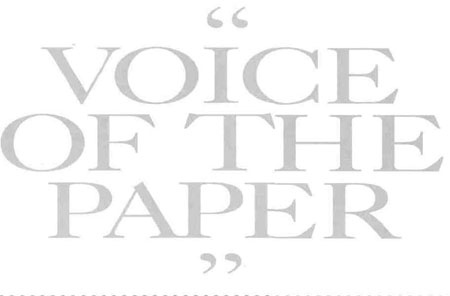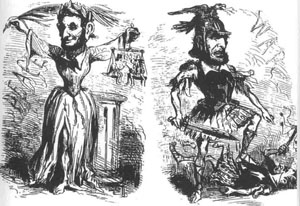|
C U R R I C U L U M M A T E R I A L S
|
Paula Seifert
Overview
Main Ideas
As Thomas Jefferson once said,
"Were it left to me to decide whether we
should have a government without newspapers or newspapers without government, I
should not hesitate to prefer the latter." In
1735, John Peter Zenger, a German immigrant who ran a printing press, went on trial
for publishing accusations against the governor of New York. The outcome of his trial
helped to establish a freedom deemed so
vital that the Founding Fathers included it in
the Bill of Rights, freedom of the press. By
1775 thirty-seven colonial newspapers took
sides based on political viewpoints. The
country's first daily paper was established in
1783 in Pennsylvania. These early publications covered little news; rather, they were
a medium for essays, letters, editorials, and
advertising. In 1833 Benjamin Day started
the New York Sun, which carried real news,
selling for one cent. At this price, newspapers became accessible to more of the
American public. A large city may have
been home to eight or nine competing
papers. In 1844 a new invention — the telegraph — accelerated the transmission of
newsworthy events. However, it did not
come into wide usage until the Civil War.
A free press is central to democratic
government, but with that role comes
responsibility. Too often, that duty becomes
clouded by a journalist's bias that comes
through in his/her writing. Beginning with
George Washington, every American president has differed with newspapers covering
their administrations. Abraham Lincoln was
no exception. Even his hometown press in
Springfield, Illinois, had competing papers—
the Illinois State Journal and the Illinois
State Register—that varied in their political
philosophies. Although Lincoln had an
uncanny ability to turn bad news into humor,
he was not immune to negative press. He
may not have read newspapers on a daily
basis in the White House, but he certainly
was aware of what they were saying about
him. He said, "Public opinion in this country
is everything." Lincoln certainly understood
the importance of newspapers in a democracy.
Connection with the Curriculum
These lessons are appropriate for
U.S. history, government, or language arts.
Teaching Level
Grades 10-12, as presented.
Grade 8, modified lessons.
Materials for Each Student
• A copy of the narrative portion
of this article
• Overhead transparencies of present-day editorials and political cartoons.
These can be copied and given as
handouts.
• Overhead transparencies of political
cartoons of Lincoln that were published during the Civil War
• Copies of the weekend newspaper
comic sections
• Research materials on Lincoln
• Coloring tools: markers, crayons,
or colored pencils
• Unlined paper
Objectives for Each Student
• Understand the role of newspapers
in a democratic society.
• Recognize underlying bias
in printed material.
• Analyze political cartoons
and their messages.
• Evaluate information received
through the various media.
33
SUGGESTIONS FOR
TEACHING THE LESSON
|
Opening the Lesson
Have students recall recent newspaper headlines and their initial reactions to
them. Headlines could include "Rosty's bad
ways mean jail"; "Americans stand their
ground in Russia"; and "U.S. seizes
Unabomber suspect." Discuss any underlying prejudice in these headlines. Read a
recent editorial, either from the school paper
or a local one. Discuss the intent of the editorial. Concerning the Civil War, discuss the
division in the United States according to
political philosophies, including that of
Abraham Lincoln. Assign the activities.
Developing the Lesson
In the first activity, students will write
two short editorials (one or two paragraphs
each) about events during Lincoln's administration. They will adopt a pro-Lincoln
stance in one of the articles, writing for the
Illinois State Journal and then an anti-Lincoln stance, for the Illinois State
Register. The students will need to be
reminded that an editorial is a forum for the
newspaper staff to air its opinion on a certain issue.
The second activity will require some
research into Lincoln's life during his presidency. The student will write a short article
about Lincoln that would have been so
important to the President that he was
carrying in his pocket when he died. It may
have been something personal about a family member or a particular event in the war.
The third activity is one in which a
student with artistic talent can be most
effective. Using overhead transparencies
or copies, the students will view political
cartoons of Lincoln during his terms as
president. The students should discuss
what the cartoonist was saying in each
one. The students will then design their
own political cartoon about Lincoln.
Students less artistically inclined can
trace pictures of Lincoln or current cartoon
characters and create some message
about Lincoln. Students should be reminded
that the cartoons need not be humorous; sarcasm or irony is acceptable.
Concluding the Lesson
Volunteers will read aloud their editorials while the rest of the class guesses
whether it is pro-or anti-Lincoln. Several
cartoons can be copied onto overhead
transparencies and shared with the class
while the students interpret what the cartoonist was telling his audience. Students
will share their articles about Lincoln.
Extending the Lesson
Have students bring in copies of current editorials, cartoons, or articles and
share their reactions with the class.
Assessing the Lesson
The editorials, cartoons, and articles
will be assigned grades as to each
teacher's expectations. Originality, clarity,
and writing styles should be the main points
assessed.
34

The newspaper editorial is often referred to as the "voice of the paper." Different types
of editorials have different intentions. One might be written to explain an issue, criticize a
policy, answer a criticism, warn the reader, or to praise someone. The main idea of an editorial is to grab the attention of its readers, then to persuade the reader to agree with the
newspaper's view.
Choosing one of the following events, you have been assigned to write a pro-Lincoln
editorial for the Illinois State Journal and an anti-Lincoln editorial for the Illinois State
Register. Remember, at the conclusion of your editorials, you want the reader to agree
with you.
Event 1
In 1861 Mrs. Lincoln overspent a $20,000 congressional appropriation by $6,700 for
the purpose of redecorating the White House. With the money she purchased new china,
books, carpets, heating, and lighting. Fearing that her husband would become angry, Mary
Lincoln asked the Commissioner of Public Buildings to explain these overruns to the president. When Mr. Lincoln learned of his wife's actions, he was so incensed that he said that
"it would stink in the nostrils of the American people..."
Event 2
Emilie Todd, Mary Todd Lincoln's younger half-sister, married a West Point graduate in
1856. In 1861 President Lincoln offered Ben Hardin Helm a commission in the Union army
which he declined, instead joining the Confederate side. He was killed at Chicamauga in
1863. Mrs. Lincoln convinced her husband to invite Emilie and her daughter to the White
House for a visit. When a wounded Union general, Dan Sickles, learned of this, he went
straight to the President to confront him about the rebel staying at the White House. Shortly
thereafter, Emilie Helm and her daughter left with a presidential pass to get her safely
through Union lines. However, Lincoln later revoked this pass.

35

At the time of Lincoln's assassination, his pockets contained the following: 1) one pair of
gold-rimmed spectacles, 2) one pair of folding spectacles, 3) one ivory pocket knife, 4) one
watch fob, 5) one large handkerchief, 6) one sleeve button, 7) a leather wallet holding a
Confederate note and nine newspaper clippings. After studying Lincoln during his presidency, write a three to four paragraph article that could have been so important to Lincoln that
he carried it at the time of his death. Remember, an article should be an accurate, unbiased
account that presents the facts from a non-partisan viewpoint.
36

If a picture is worth a thousand words, then an editorial cartoon could be said to be worth
a thousand editorials. An editorial cartoon is usually simply designed and centers on one
topic. After you have viewed political cartoons about Lincoln, design your own cartoon,
drawing freehand or tracing. You may wish to use Lincoln or perhaps a current cartoon
character that discusses something about Lincoln's policies. You should first choose
whether you will adopt a pro-or anti-Lincoln view. After drawing your cartoon, add text, if
desired, then color it. Consider the cartoons below from Samuel A Tower, Cartoons: The Art
of Political Satire (New York: Simon and Schuster, 1982), pp. 108-109. They depict alternative views of Lincoln in the North—peacemaker and conqueror.

Click Here to return to the Article
37
|



